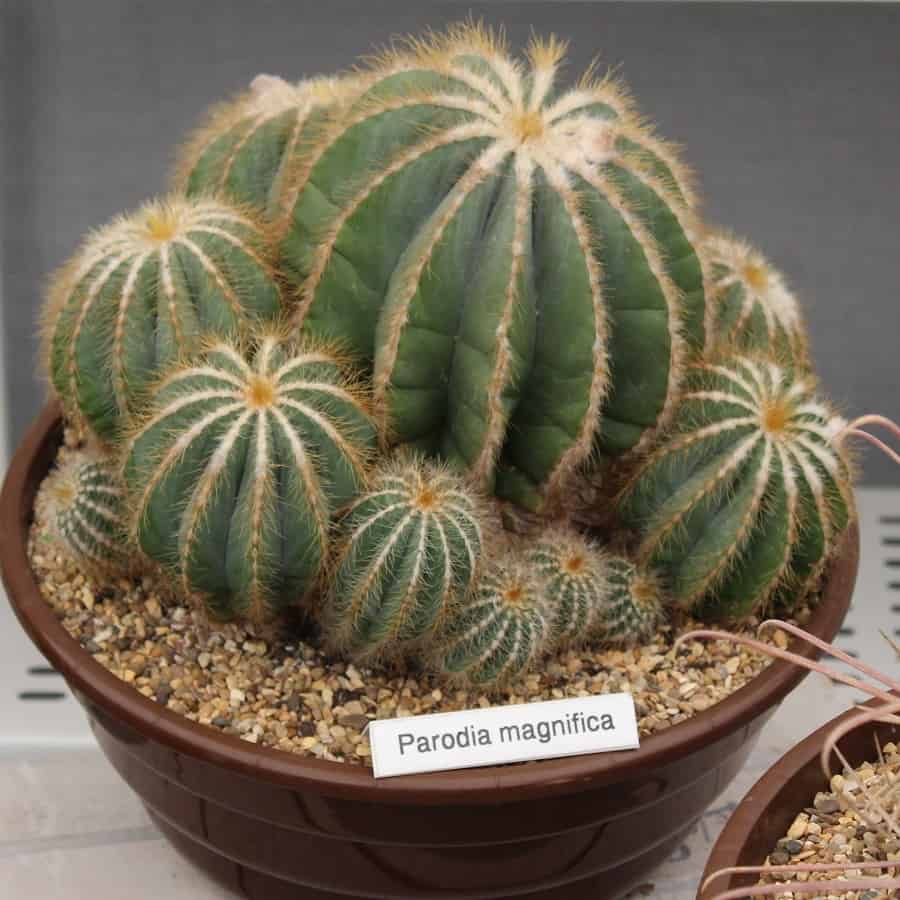Parodia Magnifica is a cactus endemic to Brazil, specifically Rio Grande do Sul, which has conquered the hearts of millions of cactus-addicts for its shape and color, but also and above all for its beautiful and large yellow flowers.
Parody magnifies usually reaches a height of 1 meter.
They form exemplary colonies.
This species develops globose to columnar stems, bluish-grayish green, approximately 35 cm high, more or less 15 cm in diameter, and with the apex slightly depressed.
Each stem is divided into 12 well conspicuous vertical ribs, parallel and separated from each other.
There are small areolas in the margin of the ribs from which 10 very soft yellow acicular spikes (approximately) sprout, about 3 cm long.
The flowers appear on the parodia magnifica after 3 years of growth.
In this species, the flowers are quite large, easily exceeding 4 cm in diameter.
Its flowering occurs in the summertime and provided it has sufficient sunlight, and although its flowers do not last long, they are located in the upper areolas of the succulent.
The stamens have yellow anthers, and the multilobed stigma is yellowish-white.
The fruits are globose, do not exceed 1.2 cm in length, and tend to take on a reddish color when ripe.
Inside the fruits, there are dozens of brownish seeds that germinate easily.
This is an easy to grow plant, used in rockeries, greenhouses, cactus and succulent gardens, as well as in tall and wide pots.
Parodia Magnifica Care
This succulent is extremely easy to maintain if the following care is taken.
Illumination
It is recommended to cultivate in full sun throughout the year to achieve optimal growth and a beautiful flowering. Shade cultivation will cause a cessation of growth and will not flourish.
Although you can have your Parody Magnifica in full sun, you have to protect yourself from the intense summer sun, especially if you live in an area with a Mediterranean or arid climate.
All this to prevent the cactus from burning. If in the area where you live, the summer does not last for many months, you can have it in full sun.
You should only be aware of the plant, if you see that the Parodia Magnifica begins to turn brownish yellow, it is best to give your plant a little shade, to prevent it from burning further.
Temperature
Parodia Magnifica prefers to develop in climates with cool to warm temperatures between 16ºC-26ºC for much of the year.
Do not expose to temperatures close to 0ºC.
Remember that this plant is a cactus, and they are from tropical areas, so they prefer heat.
If the plant is outdoors during winter, it’s best to put it inside your home to prevent the fungus from forming on the plants or the roots to rot.
Substratum
Fairly tolerant to a wide variety of substrates as long as they have good aeration and permeability.
Commercial substrates for cacti can be used without any problems.
The soil could be a mix of 1/3 coarse sand, 1/3 blonde peat, and 1/3 topsoil.
Another option is:
2 parts universal substrate.
½ part of worm castings (optional).
2 parts of sand (you can replace it with perlite, cheek or volcanic clay).
1 part of akadama (you can substitute it for dolomite, zeolite, kiryuzuna or vermiculite.
Pots:
One of the most important things about succulents and cactus pots is that they have drainage holes.
Since we use substrates with a large drainage capacity, the pot has to be able to expel the excess water from the bottom to keep the roots away from excess moisture.
These holes are also very useful; they help us know when the plant needs a transplant, its roots can be seen through the holes.
Watering
Water once a week (maximum) during the warm seasons to obtain an optimal level of hydration in the stems.
During the winter season it is recommended to carry out monthly irrigation only.
You must be very careful when watering your parodia magnifica; these plants die easier from over-watering than from lack of it.
A trick to make sure when is the best time to water your plant is by inserting a stick in the substrate until the middle of the pot (if you have it directly in the garden, insert the stick about 3 to 4 cm deep).
All this is to ensure that the substrate is completely dry. If that’s the case, you can water your plant without worry.
Fertilizer
Although fertilizer is not 100% necessary, your cactus will appreciate it.
Fertilizers help the plant grow much stronger and faster.
It is best to add it in summer. You can use a specific fertilizer purchased for cacti and succulents.
Or you can also make your own fertilizers at home.
Diseases
Although it is quite resistant, it can be affected by aphids, mites, and mealybugs. Pests can also promote the appearance of pathogenic fungi.
Always use disinfected substrates to avoid fungal or nematode attacks on the roots.
Transplant
The transplant is carried out in the spring.
Propagation
First, we must obtain the seeds and place them in a pot accompanied by a substrate that allows the water to drain and that is loose enough.
In this first stage, it should be placed in the shade and take care not to overwater, an optimal sprout will show a small plant after a week, and in approximately, you will be able to count on a cactus of about 10 to 15 cm.
You can also propagate the cactus through a shoot of a larger plant by cutting; after place the shoot in a pot with a substrate that meets the requirements. Make sure not to overwater.
Pruning
Pruning is not necessary only if you have old or damage leaves.
